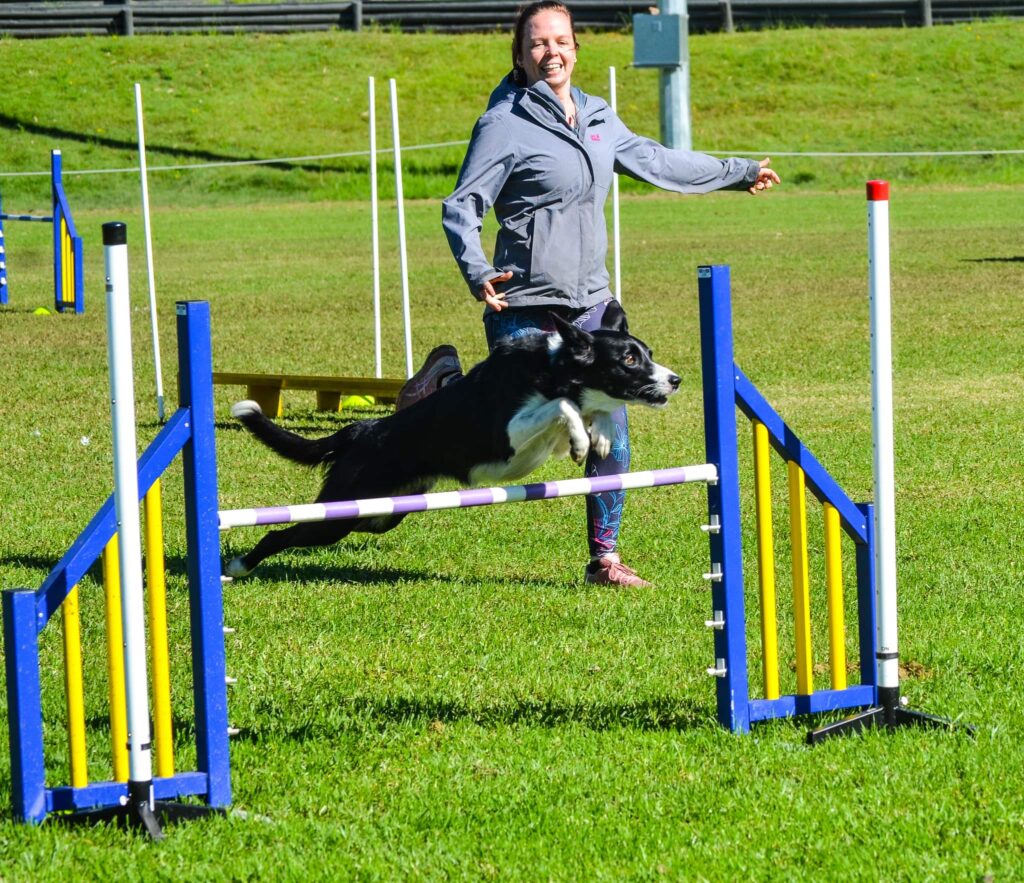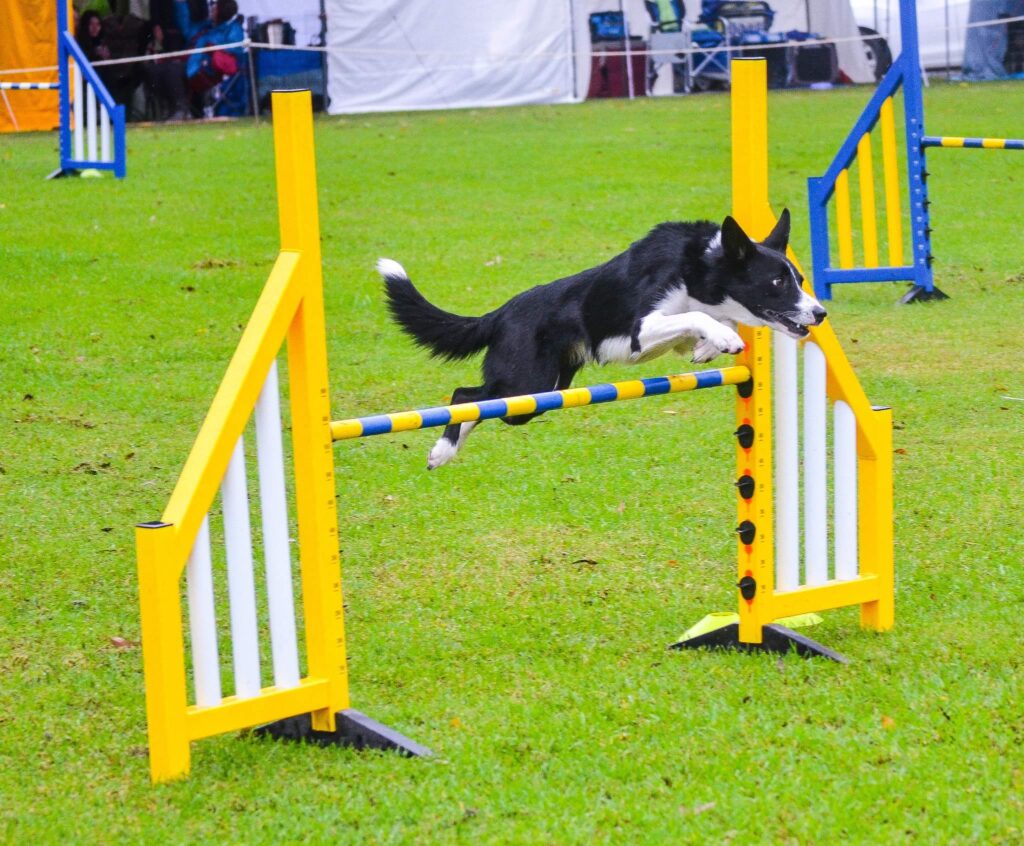An anterior cruciate ligament (ACL) tear is the most common orthopedic injury in dogs and a major reason for presenting to your vet with rear limb lameness. It can cause varying degrees of pain and lameness from a subtle limp to a non-weight bearing lameness. If left untreated, the instability from an ACL tear can lead to early-onset osteoarthritis as the knee tries to stabilize itself. Surgical correction through Tibial Plateau Levelling Osteotomy (TPLO) is the current gold standard for treating ACL tear in dogs. This article will look at current research on returning to dog agility after TPLO.
Note that “dog ACL tear” is a term commonly used for this type of injury, although your vet may refer to it as the “cranial cruciate rupture”, which is the proper name in dogs. To keep things simple, we use the term “dog ACL tear.”
Dog Agility ACL Tear Risk Factors
Before looking more at returning to dog agility after TPLO surgery it’s important to consider the risk factors for ACL tear in dogs, especially as it relates to dog agility.
Risk Factors that Decrease the Chance of ACL Tear
In 2022 Sellon & Marcellin-Little released a study titled “Risk factors for cranial cruciate ligament rupture in dogs participating in canine agility”. Interestingly, the study found that participating in higher-level agility competitions DECREASED the incidence of ACL tear in dogs. While this seems counter-intuitive, the findings that lower the risk was as follows:
- Competing at higher levels of agility,
- Competing more frequently,
- Competing in more technically challenging events
- Competing in UKI-sponsored events, and
- Undergoing regular conditioning, core strengthening, and balance program.

Risk Factors that Increase the Chance of ACL Tear
When it comes to INCREASED risk factors for ACL tear in dogs; The general risk factors for ACL tear in dogs remained the same with excess weight, middle age, female, early spay, and large/giant breeds more likely to suffer an ACL tear.
Agility-specific risk factors included:
- Competing at a lower level (e.g. novice, intermediate, open),
- Competing in fewer events per year, and
- Competing in NADAC-sponsored events
If you’ve ever watched high-level agility vs local agility then this makes sense. When was the last time you watched an overweight deconditioned dog run at Crufts, Westminster, the European or World Championships? These dog and handler teams train like elite athletes. The dogs are bred with a purpose (both temperament and orthopedic / breed history); they are not desexed early; they are kept lean and have excellent body condition scores; are super-fit; regularly compete or have access to full training venues; participate in conditioning programs to complement their training; utilize a team of complementary practitioners to keep them in optimal health.
When we compare this to the increased risk in lower-level competitors, you have to consider the general ACL tear risk factors as well as the typical progression of ACL disease. Remember that ACL tears in dogs are typically degenerative in nature, they happen over time. So in agility, it is most likely that typical ACL disease occurred in most affected dogs.
Returning to Dog Agility after TPLO Surgery
TPLO surgery is currently considered the gold standard for the treatment of ACL tears in dogs. Veterinary Orthopedic and Sports Medicine Group (VOSM) reports that “TPLO surgery provides a more rapid recovery, improved range of motion, reduction in the progression of arthritis, and can return the patient to complete pre-injury performance”.
A 2018 study by Heidon et al. looked at the rate of return to agility competition for dogs with ACL tear treated with TPLO at VOSM over a 7-year period. While the sample size of agility dogs wasn’t big (31 of >1000 TPLO dogs), 65% of dogs returned to agility competition after TPLO. 80% of dogs returned to agility before 9 months (average 7.5 months). Of those that didn’t return to agility, over 50% cited non-dog-related reasons like lack of time.
The study also found that no dog that returned to competition sustained an injury to the TPLO limb during the follow-up period. There was also no significant difference identified between dogs that returned or did not return to agility competition regarding the severity of osteoarthritis or meniscal injury.
It is important to note that VOSM, where the study was conducted, is a specialist veterinary center in the United States with world-renowned surgeons that perform hundreds of TPLO’s a year. As part of the recovery, they also include rehabilitation and a return to sport program that will no doubt be contributing factors to the successful return to dog agility.
What Does This Mean?
If your dog has just undergone a TPLO and you’re considering a return to agility it’s important that you have a great surgeon, as well as a good rehab team, and return to sport program. You also want to minimize any of the risk factors for ACL tear within your control:
Your dog should have:
- An excellent body condition score (4/9) so it isn’t carrying any unnecessary load on the knee
- No strength deficits in the operated leg
- Good general conditioning and balance
- Clearance from your surgeon or rehabilitation vet to return to agility
- Ideally, you and your dog will be experienced agility competitors rather than learning the sport
Conclusion
Early research suggests that returning to agility post TPLO is achievable. It typically takes 7-9 months to return to sport with the help of a good team. Surgery is just the start of the recovery – a good quality rehabilitation and a return to sport program will be instrumental in giving you and your dog the best chance at returning to competitive agility.
Our article titled Dog ACL Surgery: Home Exercises gives a good outline of what a rehab program may include. This program is targeted at pet dogs and DOES NOT include a return to sport program. If you need help with a rehab or return to sport program, please don’t hesitate to get in contact.

